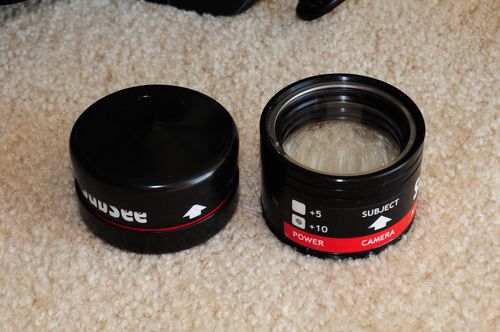Diffraction tests with the Nikon 105mm lens
I had done some diffraction tests previously when I reviewed the Nikon 105mm VR lens, but I hadn’t tested the diffraction at 1:1 magnification, and I often use this lens at 1:1 when doing underwater photography. There were a couple reasons why I thought the results might be different, so I sat down and did some tests. Here are the results:
This all started when someone on a German underwater photography forum commented about some of my supermacro photos taken at F25 with a SubSee Diopter. They seemed to think that diffraction would blur my results and that I should have taken photographs at a larger aperture.
Defining Diffraction
Let me take a moment to define diffraction. Light waves traveling through the lens aperture get dispersed when the aperture is very small. This causes a loss of sharpness at small apertures, known as diffraction. Stated another way, diffraction is an effect that happens when light passes through a very small opening. The smaller the opening, the more this effect results in the image getting blurred. Read a more thorough tutorial here.
Now I know many people who shoot 1:1 macro and beyond at F25, and even smaller apertures, and I’ve seen good results. Although the aperture range of the Nikon 105mm lens when focused at infinity is F2.8 – F32, at 1:1 magnification the aperture range changes to F4.8 – F57, a difference of 1 2/3 stops. Try it yourself at home!
Since the physical aperture of the lens hasn’t changed, I thought that I might see different amounts of diffraction at F25 when shooting 1:1, than I would when shooting at a normal distance, since the camera is most likely showing just the effective aperture.
Diffraction Test Results
Here’s my test results, with the camera at 1:1 magnification, with comments. Taken indoors with my D300, internal flash, ISO 200, 1/250th. Normal sharpening applied in camera. These are jpegs straight out of the camera.
I chose a flat subject (a postcard) with an extremely fine pattern, almost impossible to see with the naked eye, so that any diffraction effects would be very obvious.
Here’s the test subject, original size. It has quite a fine pattern, don’t you think? The photo is 24mm across. What aperture was this photo taken at? Well, you can’t tell! And it doesn’t matter. Diffraction is not noticeable without magnifying the photo.
F6.3, 100% crop. Depth of field was very narrow and much of the photo was out of focus.
F8, 100% crop. Depth of field was still very narrow and much of the photo was out of focus.
F10, 100% crop. Still not enough depth of field when I looked at the original photo.
F14, 100% crop. Photo could still have used more DOF, although most of it was in focus.
F20, 100% crop. This still looks quite sharp to me for a 100% crop, and I have sufficient depth of field in the original uncropped photo.
F25, 100% crop. A fellow photographer commented to me that the diffraction effects were quite noticeable here. It’s all subjective.
F29, 100% crop
F32, 100% crop. Now it’s looking slightly blurry to me, I can start to see the effects of diffraction. But it’s not easy to notice. Let’s try a little sharpening in photoshop?
F32, 100% crop, unsharp mask (115%, pixel width 1.5, threshhold 3). This looks very good to me, very acceptable, especially for pixel peeping!
F40, 100% crop. Now it’s starting to look somewhat blurry.
F40, with unsharp mask applied. Not as good as the results at F32, right?
F57, 100% crop. Definitely seeing some diffraction here
F57, viewing a 1900×1400 portion of the original photo (about 1/4 of it). I can’t believe F57 looks decent. well, it’s just a web-sized photo. Only upon more magnification can you see the blur.
Conclusions:
When shooting at 1:1 magnification and beyond, use the aperture you need to get sufficient depth of field. Details will be preserved even at small apertures. If your photos are just being viewed on the web, then diffraction will not be noticed.
Underwater Photography Tips:
Use manual strobe power at small apertures when doing 1:1 and supermacro, because TTL can have a difficult time getting exposures correct, and will often under-expose.
Further Reading
Aperture and Depth of Field in Underwater Photography
More diffraction tests with my 105mm lens
























